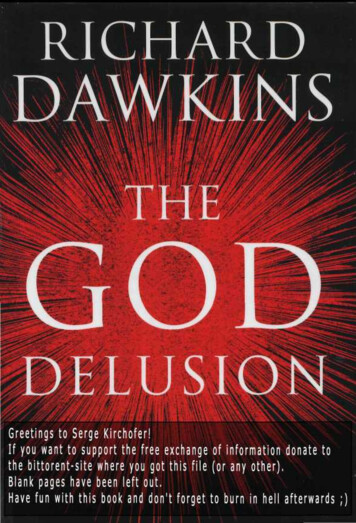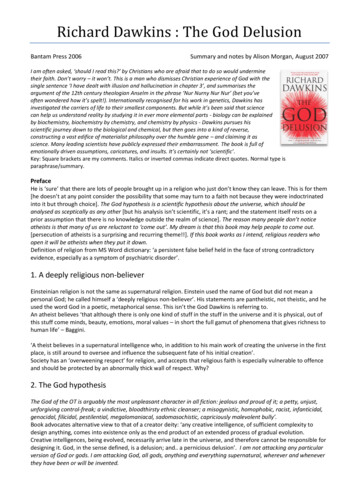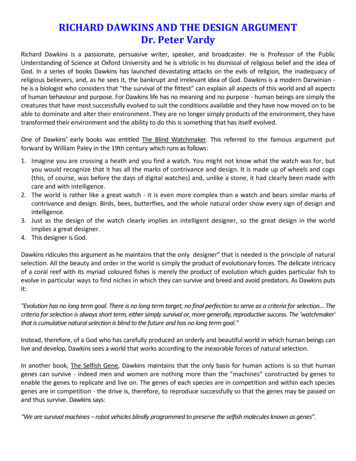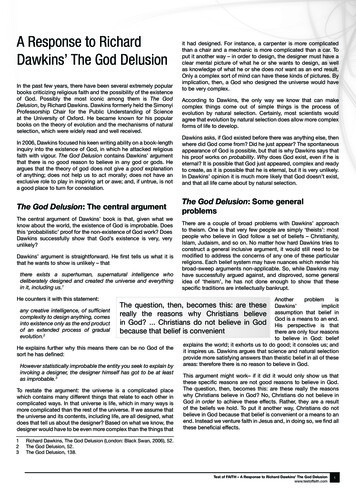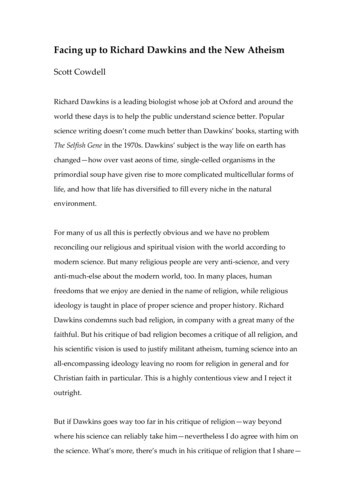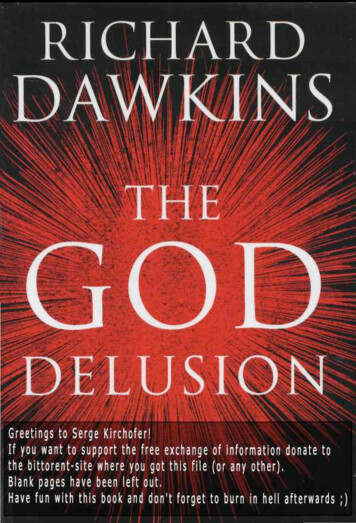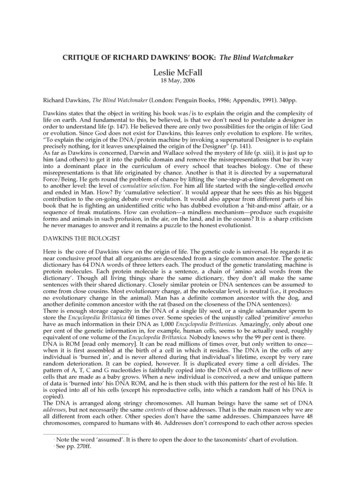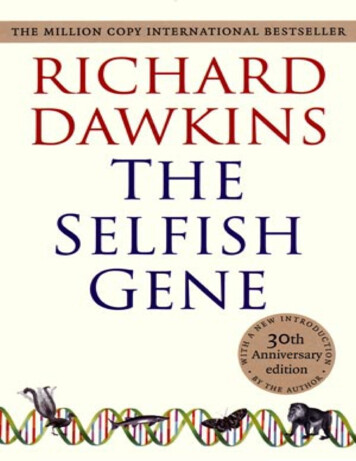
Transcription
RICHARD DAWKINS-The Selfish Gene.Ebook v1.0.'Who should read this book? Everyone interested in the universe and their place in it.'Jeffrey R. Baylis, Animal BehaviourOur genes made us. We animals exist for their preservation and are nothing more than theirthrowaway survival machines. The world of the selfish gene is one of savage competition, ruthlessexploitation, and deceit. But what of the acts of apparent altruism found in nature-the bees whocommit suicide when they sting to protect the hive, or the birds who risk their lives to warn the flockof an approaching hawk? Do they contravene the fundamental law of gene selfishness? By no means:Dawkins shows that the selfish gene is also the subtle gene. And he holds out the hope that ourspecies-alone on earth-has the power to rebel against the designs of the selfish gene. This book is acall to arms.It is bothmanual and manifesto, and it grips like a thriller.The Selfish Gene, Richard Dawkins's brilliant first book and still his most famous, is an internationalbestseller in thirteen languages. For this new edition there are two major new chapters.
'learned, witty, and very well written.exhilaratingly good.'Sir Peter Medawar, SpectatorRichard Dawkins is a Lecturer in Zoology at Oxford University and a Fellow of Mew College, andthe author of The Blind Watchmaker.
Preface to 1976 editionThis book should be read almost as though it were science fiction. It is designed to appeal to theimagination. But it is not science fiction: it is science. Cliche or not, 'stranger than fiction' expressesexactly how I feel about the truth. We are survival machines-robot vehicles blindly programmed topreserve the selfish molecules known as genes. This is a truth which still fills me with astonishment.Though I have known it for years, I never seem to get fully used to it. One of my hopes is that I mayhave some success in astonishing others.Three imaginary readers looked over my shoulder while I was writing, and I now dedicate the bookto them. First the general reader, the layman. For him I have avoided technical jargon almost totally,and where I have had to use specialized words I have defined them. I now wonder why we don'tcensor most of our jargon from learned journals too.I have assumed that the layman has no special knowledge, but I have not assumed that he is stupid.Anyone can popularize science if he oversimplifies. I have worked hard to try to popularize somesubtle and complicated ideas in non-mathematical language, without losing their essence. I do notknow how far I have succeeded in this, nor how far I have succeeded in another of my ambitions: totry to make the book as entertaining and gripping as its subject matter deserves. I have long felt thatbiology ought to seem as exciting as a mystery story, for a mystery story is exactly what biology is. Ido not dare to hope that I have conveyed more than a tiny fraction of the excitement which the subjecthas to offer.My second imaginary reader was the expert. He has been a harsh critic, sharply drawing in his breathat some of my analogies and figures of speech. His favourite phrases are with the exception of; 'but onthe other hand'; and 'ugh'. I listened to him attentively, and even completely rewrote one chapterentirely for his benefit, but in the end I have had to tell the story my way. The expert will still not betotally happy with the way I put things. Yet my greatest hope is that even he will find something newhere; a new way of looking at familiar ideas perhaps; even stimulation of new ideas of his own. If thisis too high an aspiration, may I at least hope that the book will entertain him on a train.'The third reader I had in mind was the student, making the transition from layman to expert. If he stillhas not made up his mind what field he wants to be an expert in, I hope to encourage him to give myown field of zoology a second glance. There is a better reason for studying zoology than its possible'usefulness', and the general likeableness of animals.This reason is that we animals are the most complicated and perfectly-designed pieces of machineryin the known universe. Put it like that, and it is hard to see why anybody studies anything else! For thestudent who has already committed himself to zoology, I hope my book may have some educationalvalue. He is having to work through the original papers and technical books on which my treatment isbased. If he finds the original sources hard to digest, perhaps my non-mathematical interpretation mayhelp, as an introduction and adjunct.There are obvious dangers in trying to appeal to three different kinds of reader. I can only say that Ihave been very conscious of these dangers, but that they seemed to be outweighed by the advantages
of the attempt.I am an ethologist, and this is a book about animal behaviour. My debt to the ethological tradition inwhich I was trained will be obvious. In particular, Niko Tinbergen does not realize the extent of hisinfluence on me during the twelve years I worked under him at Oxford. The phrase'survival machine', though not actually his own, might well be. But ethology has recently beeninvigorated by an invasion of fresh ideas from sources not conventionally regarded as ethological.This book is largely based on these new ideas. Their originators are acknowledged in the appropriateplaces in the text; the dominant figures are G. C. Williams, J.Maynard Smith, W. D. Hamilton, and R. L. Trivers.Various people suggested titles for the book, which I have gratefully used as chapter titles: 'ImmortalCoils', John Krebs; 'The Gene Machine', Desmond Morris; 'Genesmanship', Tim Glutton-Brock andJean Dawkins, independently with apologies to Stephen Potter. Imaginary readers may serve astargets for pious hopes and aspirations, but they are of less practical use than real readers and critics.I am addicted to revising, and Marian Dawkins has been subjected to countless drafts and redrafts ofevery page. Her considerable knowledge of the biological literature and her understanding oftheoretical issues, together with her ceaseless encouragement and moral support, have been essentialto me.John Krebs too read the whole book in draft. He knows more about the subject than I do, and he hasbeen generous and unstinting with his advice and suggestions. Glenys Thomson and Walter Bodmercriticized my handling of genetic topics kindly but firmly. I fear that my revision may still not fullysatisfy them, but I hope they will find it somewhat improved. I am most grateful for their time andpatience. John Dawkins exercised an unerring eye for misleading phraseology, and made excellentconstructive suggestions for re-wording. I could not have wished for a more suitable 'intelligentlayman' than Maxwell Stamp. His perceptive spotting of an important general flaw in the style of thefirst draft did much for the final version. Others who constructively criticized particular chapters, orotherwise gave expert advice, were John Maynard Smith, Desmond Morris, Tom Maschler, NickBlurton Jones, Sarah Kettlewell, Nick Humphrey, Tim Glutton-Brock, Louise Johnson, ChristopherGraham, Geoff Parker, and Robert Trivers. Pat Searle and Stephanie Verhoeven not only typed withskill, but encouraged me by seeming to do so with enjoyment. Finally, I wish to thank MichaelRodgers of Oxford University Press who, in addition to helpfully criticizing the manuscript, workedfar beyond the call of duty in attending to all aspects of the production of this book.RICHARD DAWKINS
Preface to 1989 editionIn the dozen years since The Selfish Gene was published its central message has become textbookorthodoxy. This is paradoxical, but not in the obvious way. It is not one of those books that wasreviled as revolutionary when published, then steadily won converts until it ended up so orthodox thatwe now wonder what the fuss was about. Quite the contrary. From the outset the reviews weregratifyingly favourable and it was not seen, initially, as a controversial book. Its reputation forcontentiousness took years to grow until, by now, it is widely regarded as a work of radicalextremism. But over the very same years as the book's reputation for extremism has escalated, itsactual content has seemed less and less extreme, more and more the common currency.The selfish gene theory is Darwin's theory, expressed in a way that Darwin did not choose but whoseaptness, I should like to think, he would instantly have recognized and delighted in. It is in fact alogical outgrowth of orthodox neo-Darwinism, but expressed as a novel image.Rather than focus on the individual organism, it takes a gene's-eye view of nature. It is a different wayof seeing, not a different theory. In the opening pages of The Extended Phenotype, I explained thisusing the metaphor of the Necker cube.This is a two-dimensional pattern of ink on paper, but it is perceived as a transparent, threedimensional cube. Stare at it for a few seconds and it will change to face in a different direction.Carry on staring and it will flip back to the original cube. Both cubes are equally compatible with thetwo-dimensional data on the retina, so the brain happily alternates between them. Neither is morecorrect than the other. My point was that there are two ways of looking at natural selection, the gene'sangle and that of the individual. If properly understood they are equivalent; two views of the sametruth. You can flip from one to the other and it will still be the same neo-Darwinism.I now think that this metaphor was too cautious. Rather than propose a new theory or unearth a newfact, often the most important contribution a scientist can make is to discover a new way of seeing oldtheories or facts. The Necker cube model is misleading because it suggests that the two ways ofseeing are equally good. To be sure, the metaphor gets it partly right: 'angles', unlike theories, cannotbe judged by experiment; we cannot resort to our familiar criteria of verification and falsification.But a change of vision can, at its best, achieve something loftier than a theory. It can usher in a wholeclimate of thinking, in which many exciting and testable theories are born, and unimagined facts laidbare.
The Necker cube metaphor misses this completely. It captures the idea of a flip in vision, but fails todo justice to its value. What we are talking about is not a flip to an equivalent view but, in extremecases, a transfiguration.I hasten to disclaim any such status for my own modest contributions.Nevertheless, it is for this kind of reason that I prefer not to make a clear separation between scienceand its 'popularization'. Expounding ideas that have hitherto appeared only in the technical literatureis a difficult art. It requires insightful new twists of language and revealing metaphors.If you push novelty of language and metaphor far enough, you can end up with a new way of seeing.And a new way of seeing, as I have just argued, can in its own right make an original contribution toscience.Einstein himself was no mean popularizer, and I've often suspected that his vivid metaphors did morethan just help the rest of us. Didn't they also fuel his creative genius.'The gene's-eye view of Darwinism is implicit in the writings of R. A.Fisher and the other great pioneers of neo-Darwinism in the early thirties, but was made explicit byW. D. Hamilton and G. C. Williams in the sixties. For me their insight had a visionary quality. But Ifound their expressions of it too laconic, not full-throated enough. I was convinced that an amplifiedand developed version could make everything about life fall into place, in the heart as well as in thebrain. I would write a book extolling the gene's-eye view of evolution. It should concentrate itsexamples on social behaviour, to help correct the unconscious group-selectionism that then pervadedpopular Darwinism. I began the book in 1972 when power-cuts resulting from industrial strifeinterrupted my laboratory research. The blackouts unfortunately (from one point of view) ended aftera mere two chapters, and I shelved the project until I had a sabbatical leave in 1975. Meanwhile thetheory had been extended, notably by John Maynard Smith and Robert Trivers. I now see that it wasone of those mysterious periods in which new ideas are hovering in the air. I wrote The Selfish Genein something resembling a fever of excitement.When Oxford University Press approached me for a second edition they insisted that a conventional,comprehensive, page by page revision was inappropriate. There are some books that, from theirconception, are obviously destined for a string of editions, and The Selfish Gene was not one of them.The first edition borrowed a youthful quality from the times in which it was written. There was awhiff of revolution abroad, a streak of Wordsworth's blissful dawn. A pity to change a child of thosetimes, fatten it with new facts or wrinkle it with complications and cautions. So, the original textshould stand, warts, sexist pronouns and all. Notes at the end would cover corrections, responses anddevelopments. And there should be entirely new chapters, on subjects whose novelty in their owntime would carry forward the mood of revolutionary dawn. The result was Chapters 12 and 13. Forthese I took my inspiration from the two books in the field that have most excited me during theintervening years: Robert Axelrod's The Evolution of Cooperation, because it seems to offer somesort of hope for our future; and my own The Extended Phenotype because for me it dominated thoseyears and because-for what that is worth-it is probably the finest thing I shall ever write.
The tide 'Nice guys finish first' is borrowed from the BBC Horizon television programme that Ipresented in 1985. This was a fifty-minute documentary on game-theoretic approaches to theevolution of cooperation, produced by Jeremy Taylor. The making of this film, and another. The BlindWatchmaker, by the same producer, gave me a new respect for his profession. At their best. Horizonproducers (some of their programmes can be seen in America, often repackaged under the nameNova) turn themselves into advanced scholarly experts on the subject in hand. Chapter 12 owes morethan just its title to my experience of working closely with Jeremy Taylor and the Horizon team, and Iam grateful.I recently learned a disagreeable fact: there are influential scientists in the habit of putting their namesto publications in whose composition they have played no part. Apparently some senior scientistsclaim joint authorship of a paper when all that they have contributed is bench space, grant money andan editorial read-through of the manuscript. For all I know, entire scientific reputations may havebeen built on the work of students and colleagues! I don't know what can be done to combat thisdishonesty. Perhaps journal editors should require signed testimony of what each author contributed.But that is by the way. My reason for raising the matter here is to make a contrast. Helena Cronin hasdone so much to improve every line-every word-that she should, but for her adamant refusal, benamed as joint author of all the new portions of this book. I am deeply grateful to her, and sorry thatmy acknowledgment must be limited to this. I also thank Mark Ridley, Marian Dawkins and AlanGrafen for advice and for constructive criticism of particular sections. Thomas Webster, HilaryMcGlynn and others at Oxford University Press cheerfully tolerated my whims and procrastinations.RICHARD DAWKINSContents1. Why are people?2. The replicators3. Immortal coils4. The gene machine5. Aggression: stability and the selfish machine 6. Genesmanship7. Family planning8. Battle of the generations9. Battle of the sexes10. You scratch my back, I'll ride on yours11. Memes: the new replicators12. Nice guys finish first
13. The long reach of the gene1. Why are people?Intelligent life on a planet comes of age when it first works out the reason for its own existence. Ifsuperior creatures from space ever visit earth, the first question they will ask, in order to assess thelevel of our civilization, is: 'Have they discovered evolution yet?' Living organisms had existed onearth, without ever knowing why, for over three thousand million years before the truth finallydawned on one of them. His name was Charles Darwin. To be fair, others had had inklings of thetruth, but it was Darwin who first put together a coherent and tenable account of why we exist.Darwin made it possible for us to give a sensible answer to the curious child whose question headsthis chapter. We no longer have to resort to superstition when faced with the deep problems: Is therea meaning to life.' What are we for? What is man? After posing the last of these questions, the eminentzoologist G. G. Simpson put it thus: 'The point I want to make now is that all attempts to answer thatquestion before 1859 are worthless and that we will be better off if we ignore them completely.'Today the theory of evolution is about as much open to doubt as the theory that the earth goes roundthe sun, but the full implications of Darwin's revolution have yet to be widely realized. Zoology isstill a minority subject in universities, and even those who choose to study it often make theirdecision without appreciating its profound philosophical significance. Philosophy and the subjectsknown as 'humanities' are still taught almost as if Darwin had never lived. No doubt this will changein time. In any case, this book is not intended as a general advocacy of Darwinism. Instead, it willexplore the consequences of the evolution theory for a particular issue. My purpose is to examine thebiology of selfishness and altruism.Apart from its academic interest, the human importance of this subject is obvious. It touches everyaspect of our social lives, our loving and hating, fighting and cooperating, giving and stealing, ourgreed and our generosity. These are claims that could have been made for Lorenz's On Aggression,Ardrey's The Social Contract, and Eibl-Eihesfeldt's Love and Hate. The trouble with these books isthat their authors got it totally and utterly wrong. They got it wrong because they misunderstood howevolution works. They made the erroneous assumption that the important thing in evolution is the goodof the species (or the group) rather than the good of the individual (or the gene). It is ironic thatAshley Montagu should criticize Lorenz as a 'direct descendant of the"nature red in tooth and claw" thinkers of the nineteenth century .'. As I understand Lorenz's view ofevolution, he would be very much at one with Montagu in rejecting the implications of Tennyson'sfamous phrase.Unlike both of them, I think 'nature red in tooth and claw' sums up our modern understanding of naturalselection admirably.Before beginning on my argument itself, I want to explain briefly what sort of an argument it is, andwhat sort of an argument it is not. If we were told that a man had lived a long and prosperous life inthe world of Chicago gangsters, we would be entitled to make some guesses as to the sort of man hewas. We might expect that he would have qualities such as toughness, a quick trigger finger, and theability to attract loyal friends. These would not be infallible deductions, but you can make some
inferences about a man's character if you know something about the conditions in which he hassurvived and prospered. The argument of this book is that we, and all other animals, are machinescreated by our genes. Like successful Chicago gangsters, our genes have survived, in some cases formillions of years, in a highly competitive world. This entities us to expect certain qualities in ourgenes. I shall argue that a predominant quality to be expected in a successful gene is ruthlessselfishness. This gene selfishness will usually give rise to selfishness in individual behaviour.However, as we shall see, there are special circumstances in which a gene can achieve its ownselfish goals best by fostering a limited form of altruism at the level of individual animals.'Special' and 'limited' are important words in the last sentence. Much as we might wish to believeotherwise, universal love and the welfare of the species as a whole are concepts that simply do notmake evolutionary sense.This brings me to the first point I want to make about what this book is not. I am not advocating amorality based on evolution. I am saying how things have evolved. I am not saying how we humansmorally ought to behave. I stress this, because I know I am in danger of being misunderstood by thosepeople, all too numerous, who cannot distinguish a statement of belief in what is the case from anadvocacy of what ought to be the case. My own feeling is that a human society based simply on thegene's law of universal ruthless selfishness would be a very nasty society in which to live. Butunfortunately, however much we may deplore something, it does not stop it being true. This book ismainly intended to be interesting, but if you would extract a moral from it, read it as a warning. Bewarned that if you wish, as I do, to build a society in which individuals cooperate generously andunselfishly towards a common good, you can expect little help from biological nature. Let us try toteach generosity and altruism, because we are born selfish. Let us understand what our own selfishgenes are up to, because we may then at least have the chance to upset their designs, something that noother species has ever aspired to.As a corollary to these remarks about teaching, it is a fallacy-incidentally a very common one-tosuppose that genetically inherited traits are by definition fixed and unmodifiable. Our genes mayinstruct us to be selfish, but we are not necessarily compelled to obey them all our lives. It may justbe more difficult to learn altruism than it would be if we were genetically programmed to bealtruistic. Among animals, man is uniquely dominated by culture, by influences learned and handeddown. Some would say that culture is so important that genes, whether selfish or not, are virtuallyirrelevant to the understanding of human nature. Others would disagree. It all depends where youstand in the debate over 'nature versus nurture' as determinants of human attributes.This brings me to the second thing this book is not: it is not an advocacy of one position or another inthe nature/nurture controversy. Naturally I have an opinion on this, but I am not going to express it,except insofar as it is implicit in the view of culture that I shall present in the final chapter. If genesreally turn out to be totally irrelevant to the determination of modern human behaviour, if we reallyare unique among animals in this respect, it is, at the very least, still interesting to inquire about therate to which we have so recently become the exception.And if our species is not so exceptional as we might like to think, it is even more important that weshould study the rule.
The third thing this book is not is a descriptive account of the detailed behaviour of man or of anyother particular animal species. I shall use factural details as only illustrative examples. I shall not besaying: 'If you look at the behaviour of baboons you will find it to be selfish; therefore the chances arethat human behaviour is selfish also'. The logic of my'Chicago gangster' argument is quite different. It is this. Humans and baboons have evolved by naturalselection. If you look at the way natural selection works, it seems to follow that anything that hasevolved by natural selection should be selfish. Therefore we must expect that when we go and look atthe behaviour of baboons, humans, and all other living creatures, we shall find it to be selfish. If wefind that our expectation is wrong, if we observe that human behaviour is truly altruistic, then weshall be faced with something puzzling, something that needs explaining.Before going any further, we need a definition. An entity, such as a baboon, is said to be altruistic if itbehaves in such a way as to increase another such entity's welfare at the expense of its own. Selfishbehaviour has exactly the opposite effect. 'Welfare' is defined as 'chances of survival', even if theeffect on actual life and death prospects is so small as to seem negligible. One of the surprisingconsequences of the modem version of the Darwinian theory is that apparently trivial tiny influenceson survival probability can have a major impact on evolution. This is because of the enormous timeavailable for such influences to make themselves felt.It is important to realize that the above definitions of altruism and selfishness are behavioural, notsubjective. I am not concerned here with the psychology of motives. I am not going to argue aboutwhether people who behave altruistically are 'really' doing it for secret or subconscious selfishmotives. Maybe they are and maybe they aren't, and maybe we can never know, but in any case that isnot what this book is about. My definition is concerned only with whether the effect of an act is tolower or raise the survival prospects of the presumed altruist and the survival prospects of thepresumed beneficiary.It is a very complicated business to demonstrate the effects of behaviour on long-term survivalprospects. In practice, when we apply the definition to real behaviour, we must qualify it with theword 'apparently'. An apparently altruistic act is one that looks, superficially, as if it must tend tomake the altruist more likely (however slightly) to die, and the recipient more likely to survive. Itoften turns out on closer inspection that acts of apparent altruism are really selfishness in disguise.Once again, I do not mean that the underlying motives are secretly selfish, but that the real effects ofthe act on survival prospects are the reverse of what we originally thought.I am going to give some examples of apparently selfish and apparently altruistic behaviour. It isdifficult to suppress subjective habits of thought when we are dealing with our own species, so I shallchoose examples from other animals instead. First some miscellaneous examples of selfish behaviourby individual animals.Blackheaded gulls nest in large colonies, the nests being only a few feet apart. When the chicks firsthatch out they are small and defenceless and easy to swallow. It is quite common for a gull to waituntil a neighbour's back is turned, perhaps while it is away fishing, and then pounce on one of theneighbour's chicks and swallow it whole. It thereby obtains a good nutritious meal, without having togo to the trouble of catching a fish, and without having to leave its own nest unprotected.
More well known is the macabre cannibalism of female praying mantises.Mantises are large carnivorous insects. They normally eat smaller insects such as flies, but they willattack almost anything that moves. When they mate, the male cautiously creeps up on the female,mounts her, and copulates. If the female gets the chance, she will eat him, beginning by biting his headoff, either as the male is approaching, or immediately after he mounts, or after they separate. It mightseem most sensible for her to wait until copulation is over before she starts to eat him. But the loss ofthe head does not seem to throw the rest of the male's body off its sexual stride. Indeed, since theinsect head is the seat of some inhibitory nerve centres, it is possible that the female improves themale's sexual performance by eating his head. If so, this is an added benefit. The primary one is thatshe obtains a good meal.The word 'selfish' may seem an understatement for such extreme cases as cannibalism, although thesefit well with our definition. Perhaps we can sympathize more directly with the reported cowardlybehaviour of emperor penguins in the Antarctic. They have been seen standing on the brink of thewater, hesitating before diving in, because of the danger of being eaten by seals. If only one of themwould dive in, the rest would know whether there was a seal there or not. Naturally nobody wants tobe the guinea pig, so they wait, and sometimes even try to push each other in.More ordinarily, selfish behaviour may simply consist of refusing to share some valued resource suchas food, territory, or sexual partners. Now for some examples of apparently altruistic behaviour. Thestinging behaviour of worker bees is a very effective defence against honey robbers. But the beeswho do the stinging are kamikaze fighters. In the act of stinging, vital internal organs are usually tornout of the body, and the bee dies soon afterwards. Her suicide mission may have saved the colony'svital food stocks, but she herself is not around to reap the benefits. By our definition this is analtruistic behavioural act. Remember that we are not talking about conscious motives. They may ormay not be present, both here and in the selfishness examples, but they are irrelevant to our definition.Laying down one's life for one's friends is obviously altruistic, but so also is taking a slight risk forthem. Many small birds, when they see a flying predator such as a hawk, give a characteristic 'alarmcall', upon which the whole flock takes appropriate evasive action. There is indirect evidence that thebird who gives the alarm call puts itself in special danger, because it attracts the predator's attentionparticularly to itself.This is only a slight additional risk, but it nevertheless seems, at least at first sight, to qualify as analtruistic act by our definition.The commonest and most conspicuous acts of animal altruism are done by parents, especiallymothers, towards their children. They may incubate them, either in nests or in their own bodies, feedthem at enormous cost to themselves, and take great risks in protecting them from predators. To takejust one particular example, many ground-nesting birds perform a so-called 'distraction display' whena pred
The Selfish Gene, Richard Dawkins's brilliant first book and still his most famous, is an international bestseller in thirteen languages. For this new edition there are two major new chapters. . He is having to work through the original papers and technical books on which my treatment is based. If he finds the original sources hard to digest .

